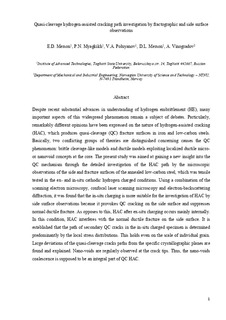| dc.contributor.author | Merson, ED | |
| dc.contributor.author | Myagkikh, PN | |
| dc.contributor.author | Poluyanov, Vitaliy | |
| dc.contributor.author | Merson, DL | |
| dc.contributor.author | Vinogradov, Alexey | |
| dc.date.accessioned | 2020-01-31T13:49:30Z | |
| dc.date.available | 2020-01-31T13:49:30Z | |
| dc.date.created | 2019-11-08T16:20:46Z | |
| dc.date.issued | 2019 | |
| dc.identifier.citation | Engineering Fracture Mechanics. 2019, 214 177-193. | nb_NO |
| dc.identifier.issn | 0013-7944 | |
| dc.identifier.uri | http://hdl.handle.net/11250/2639100 | |
| dc.description.abstract | Despite recent substantial advances in understanding of hydrogen embrittlement (HE), many important aspects of this widespread phenomenon remain a subject of debates. Particularly, remarkably different opinions have been expressed on the nature of hydrogen-assisted cracking (HAC), which produces quasi-cleavage (QC) fracture surfaces in iron and low-carbon steels. Basically, two conflicting groups of theories are distinguished concerning causes the QC phenomenon: brittle cleavage-like models and ductile models exploiting localized ductile micro- or nanovoid concepts at the core. The present study was aimed at gaining a new insight into the QC mechanism through the detailed investigation of the HAC path by the microscopic observations of the side and fracture surfaces of the annealed low-carbon steel, which was tensile tested in the ex- and in-situ cathodic hydrogen charged conditions. Using a combination of the scanning electron microscopy, confocal laser scanning microscopy and electron-backscattering diffraction, it was found that the in-situ charging is more suitable for the investigation of HAC by side surface observations because it provokes QC cracking on the side surface and suppresses normal ductile fracture. As opposes to this, HAC after ex-situ charging occurs mainly internally. In this condition, HAC interferes with the normal ductile fracture on the side surface. It is established that the path of secondary QC cracks in the in-situ charged specimen is determined predominantly by the local stress distributions. This holds even on the scale of individual grain. Large deviations of the quasi-cleavage cracks paths from the specific crystallographic planes are found and explained. Nano-voids are regularly observed at the crack tips. Thus, the nano-voids coalescence is supposed to be an integral part of QC HAC. | nb_NO |
| dc.language.iso | eng | nb_NO |
| dc.publisher | Elsevier | nb_NO |
| dc.rights | Attribution-NonCommercial-NoDerivatives 4.0 Internasjonal | * |
| dc.rights | Attribution-NonCommercial-NoDerivatives 4.0 Internasjonal | * |
| dc.rights.uri | http://creativecommons.org/licenses/by-nc-nd/4.0/deed.no | * |
| dc.rights.uri | http://creativecommons.org/licenses/by-nc-nd/4.0/deed.no | * |
| dc.title | Quasi-cleavage hydrogen-assisted cracking path investigation by fractographic and side surface observations | nb_NO |
| dc.type | Journal article | nb_NO |
| dc.type | Peer reviewed | nb_NO |
| dc.description.version | acceptedVersion | nb_NO |
| dc.source.pagenumber | 177-193 | nb_NO |
| dc.source.volume | 214 | nb_NO |
| dc.source.journal | Engineering Fracture Mechanics | nb_NO |
| dc.identifier.doi | 10.1016/j.engfracmech.2019.04.042 | |
| dc.identifier.cristin | 1745486 | |
| dc.description.localcode | © 2019. This is the authors’ accepted and refereed manuscript to the article. Locked until 9.5.2021 due to copyright restrictions. This manuscript version is made available under the CC-BY-NC-ND 4.0 license http://creativecommons.org/licenses/by-nc-nd/4.0/ | nb_NO |
| cristin.unitcode | 194,64,92,0 | |
| cristin.unitname | Institutt for maskinteknikk og produksjon | |
| cristin.ispublished | true | |
| cristin.fulltext | postprint | |
| cristin.qualitycode | 1 | |

